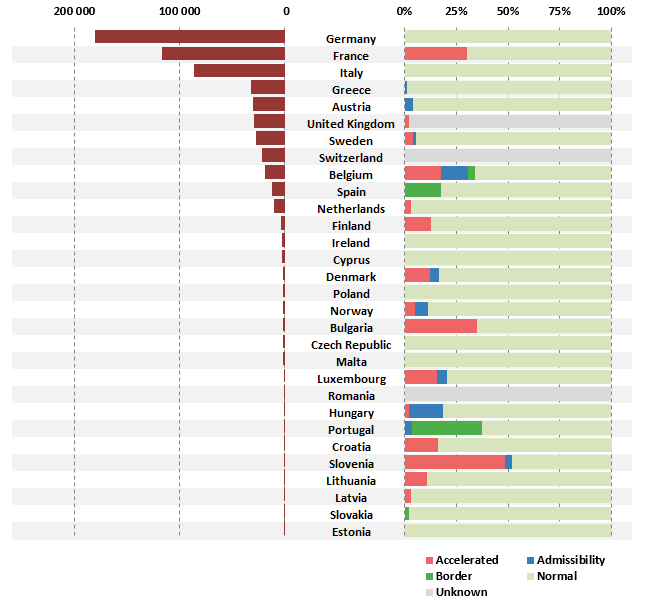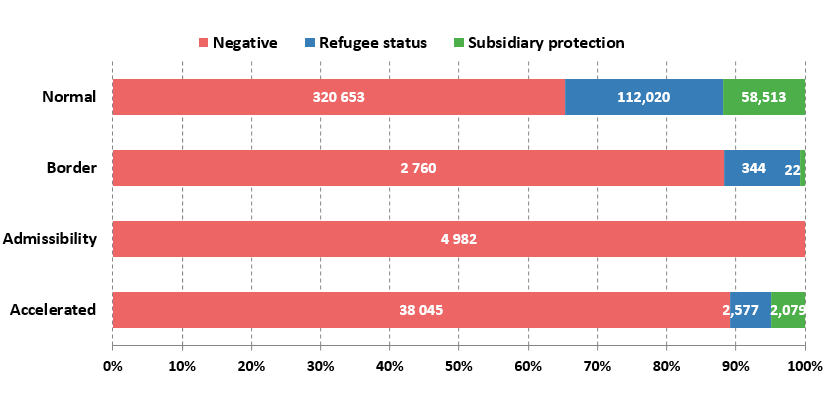The Asylum Procedures Directive sets the framework for the examination of applications for international protection at first instance under an accelerated, border or transit zones, or prioritised procedure, while remaining in accordance with the basic principles and guarantees.
Given that many applications for international protection are made at the border or in a transit zone of a Member State prior to a decision on the entry of the applicant, Member States can provide for admissibility and/or substantive examination procedures which would make it possible for such applications to be decided upon at those locations in well-defined circumstances.
When an application is likely to be unfounded or where there are specific grounds, Member States may accelerate the examination procedure 127, in particular by introducing shorter, but reasonable, time limits for certain procedural steps, without prejudice to an adequate and complete examination being carried out and to the applicant’s effective access to basic principles and guarantees provided for in the Directive. Accordingly, Member States may provide that an examination procedure in accordance with the basic principles and guarantees of the APD be accelerated and/or conducted at the border or in transit zones. Applicants in need of special procedural guarantees should be exempted from special procedures.
Where an applicant makes a subsequent application without presenting new evidence or arguments, it would be disproportionate to oblige Member States to carry out a new full examination procedure. In those cases, Member States have the possibility to dismiss an application as inadmissible in accordance with the res judicata principle. In addition to cases in which an application is not examined in accordance with the Dublin III Regulation (EU), Member States are not required to examine whether the applicant qualifies for international protection where an application is considered inadmissible
128.
In order to shorten the overall duration of the procedure in certain cases, Member States have the flexibility, in accordance with their national needs, to prioritise the examination of any application by examining it before other, previously made applications, without derogating from normally applicable procedural time limits, principles and guarantees.
EASO has included in its EPS data exchange a disaggregation regarding the use of special procedures in decision-making. Several of the countries with such procedures in law were able to provide information on the number of decisions issued at first instance since March 2014, when EASO data exchange first began, disaggregated by type of procedure (normal, border, admissibility, accelerated). However, not all countries report under the breakdown, so results should be interpreted with care.
|
Decisions issued by main country (left) and procedure (right) |
 |
|
Figure 17: The accelerated procedure was used most often in Slovenia, Bulgaria and France |
Of the EU+ countries reporting on the type of procedure used, the accelerated procedure was used most often in Slovenia (49 % of all decisions), Bulgaria (35 %) and France (30 %) (Figure 17). The admissibility procedure was used more often in Hungary (17 % of all decisions) and Belgium (13 %), and much less frequently in Greece (in about 1 % of decisions) compared to 2017. The border procedure was used the most in Portugal (34 %) and to a lesser extent in Spain (17 %), and Belgium (4 %).
While it can be observed that first-instance decisions issued in the EU+ using accelerated or border procedures resulting in negative decisions in a significantly higher proportion compared to decisions made via normal procedures, there are cases where international protection is granted using special procedures, as shown in the chart below (Figure 18) 129. Admissibility procedures resulted in 100 % negative outcomes, since a positive result on admissibility leads to the opening of an asylum procedure that considers the case on the merit – the result of this procedure is reported in asylum decision data. In contrast, the recognition rate for first-instance decisions issued using accelerated procedures was 11 %, while for those using border procedure 12 %.
|
First-instance decisions issued using special procedures in 2018, by outcome and type of procedure |
|
|
|
Figure 18: Accelerated or border procedures resulted in a similar share of positive decisions |
___
127 According the recast APD, Article 31 an examination procedure may be accelerated where (a) the applicant, in submitting his or her application and presenting the facts, has only raised issues that are not relevant to the examination of whether he or she qualifies as a beneficiary of international protection by virtue of Directive 2011/95/EU; or (b) the applicant is from a safe country of origin within the meaning of this Directive; or (c) the applicant has misled the authorities by presenting false information or documents or by withholding relevant information or documents with respect to his or her identity and/or nationality that could have had a negative impact on the decision; or (d) it is likely that, in bad faith, the applicant has destroyed or disposed of an identity or travel document that would have helped establish his or her identity or nationality; (e) the applicant has made clearly inconsistent and contradictory, clearly false or obviously improbable representations which contradict sufficiently verified country-of-origin information, thus making his or her claim clearly unconvincing in relation to whether he or she qualifies as a beneficiary of international protection by virtue of Directive 2011/95/EU; or (f) the applicant has introduced a subsequent application for international protection that is not inadmissible in accordance with Article 40(5); or (g) the applicant is making an application merely in order to delay or frustrate the enforcement of an earlier or imminent decision which would result in his or her removal; or (h) the applicant entered the territory of the Member State unlawfully or prolonged his or her stay unlawfully and, without good reason, has either not presented himself or herself to the authorities or not made an application for international protection as soon as possible, given the circumstances of his or her entry; or (i) the applicant refuses to comply with an obligation to have his or her fingerprints taken in accordance with Regulation (EU) No 603/2013 of the European Parliament and of the Council of 26 June 2013 on the establishment of Eurodac for the comparison of fingerprints for the effective application of Regulation (EU) No 604/2013 establishing the criteria and mechanisms for determining the Member State responsible for examining an application for international protection lodged in one of the Member States by a third-country national or a stateless person and on requests for the comparison with Eurodac data by Member States’ law enforcement authorities and Europol for law enforcement purposes (12); or (j) the applicant may, for serious reasons, be considered a danger to the national security or public order of the Member State, or the applicant has been forcibly expelled for serious reasons of public security or public order under national law.
128 According the recast APD, Article 33: Member States may consider an application for international protection as inadmissible only if: (a) another Member State has granted international protection;(b) a country which is not a Member State is considered as a first country of asylum for the applicant, pursuant to Article 35(c) a country which is not a Member State is considered as a safe third country for the applicant, pursuant to Article 38;(d) the application is a subsequent application, where no new elements or findings relating to the examination of whether the applicant qualifies as a beneficiary of international protection by virtue of Directive 2011/95/EU have arisen or have been presented by the applicant; or(e) a dependant of the applicant lodges an application, after he or she has in accordance with Article 7(2) consented to have his or her case be part of an application lodged on his or her behalf, and there are no facts relating to the dependant’s situation which justify a separate application.
129 Note that the chart is based on EASO EPS data, which only covers EU-regulated statuses (refugee status and subsidiary protection). Therefore, national forms of protection (for humanitarian reasons), are reported as negative decisions.

